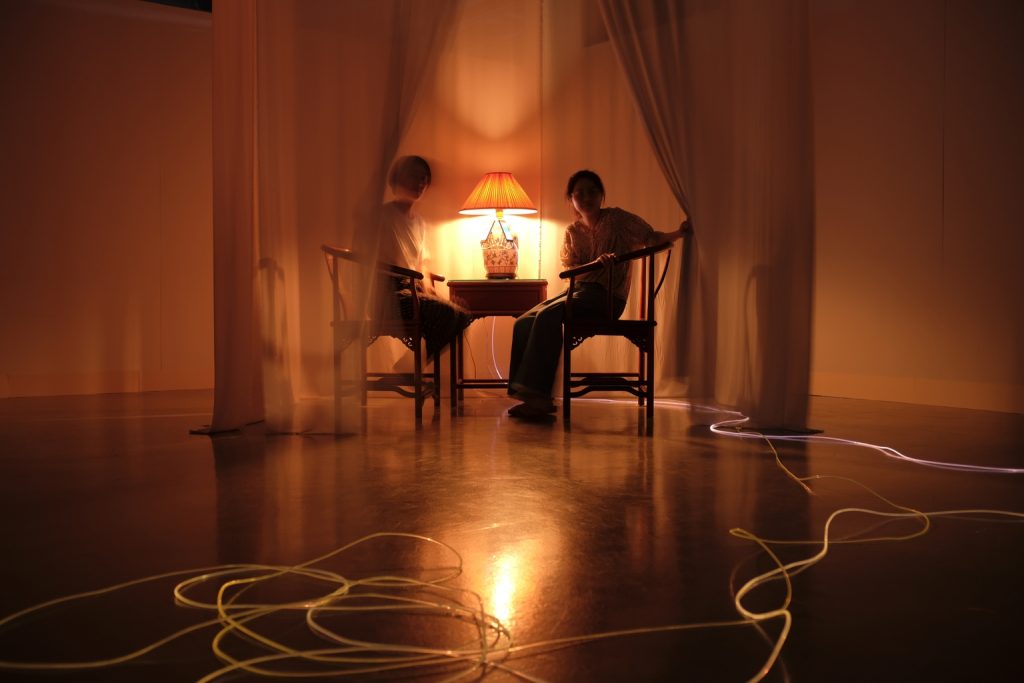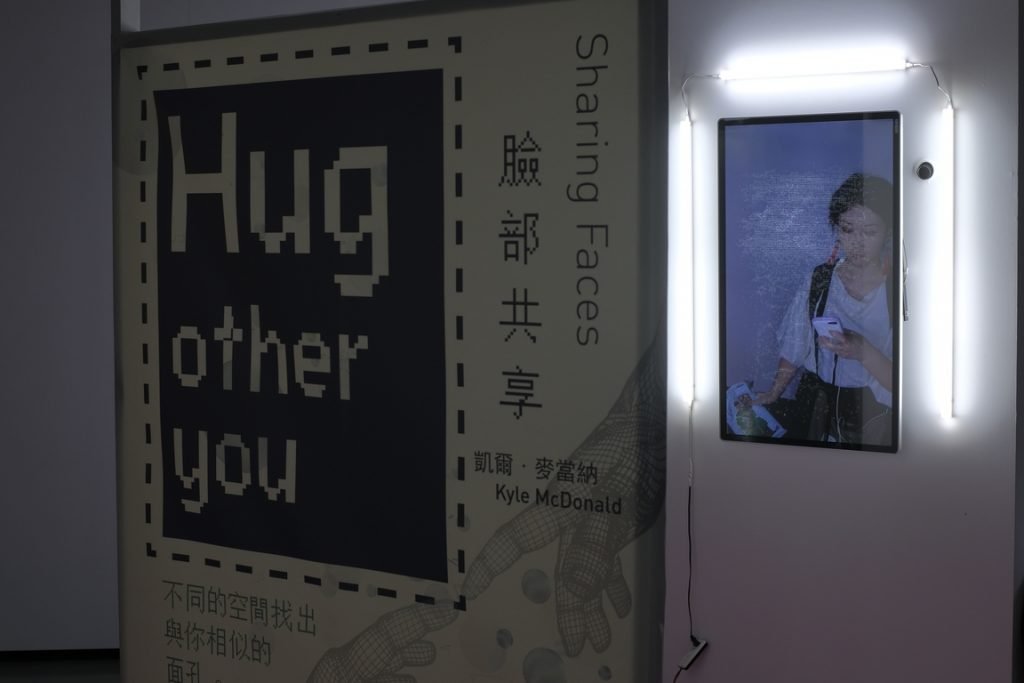CyberHug-2018 Taoyuan Art & Technology Festival
Curated by Yu-Chuan Tseng, Hideyuki Ando, Yu-Jie Lin
Date: 2018.9.27 ~ 10.14
Place: Taoyuan Arts Center, Taoyuan¸ Taiwan
Give me a CyberHug
Give me a cyberhug. ((((me.))))
In restaurants, family members dining together at the same table are holding their mobile phones and staring at the screens chatting with people over the internet. Upon the serving of the dishes, they pick up their mobile phones and take nice photos of the food to share with their Facebook friends. Then, they enjoy their food while continuing chatting with friends online, occasionally lifting their heads to look at their families across the table before lowering their heads and returning to their phones.
This real-life scenario has been happening in all families, schools, offices, restaurants and on the MRT. We inhabit a real world, but connect with each other through a virtual world constructed with technologies of the internet, intelligent computation and social media. Our lives alternate between the real and the virtual world as we express our emotions and perceive others’ through emoji. Every person’s facial expression have been replaced by the small round-face icons on the screen, or have been communicated to the world through posts and live streaming. We are publicizing our own lives in front of the public that we cannot see. The light-emitting interface guides us to keep searching for the meaning of life in the virtual “space” that exists on a sleepless screen.
We submerge ourselves in this virtual world, finding pleasure in the endless flow of information while worrying about information overload. We enjoy the happiness of strangers giving us “likes” while feeling intimidated to build real and intimate relationships with people. We feel the thrill to show ourselves all the time while being anxious about exposing our private lives. However, amidst these confusing contradictions, we still pretend that we do not care, gradually submitting ourselves to be conditioned by technology.
Living in a world defined and confined by our digital life and relying on digital messages to interact with people, it fits what Sherry Turkle states in her book, Alone Together—“a peculiar sense of loss: today, whether you use the internet or not, people eventually find it difficult to confirm whether they are getting closer or farther away from each other.”
“Cyberhug” refers to the symbol and message of virtual hugs, ((((me)))), in the online instant messaging conversation. It can be used in the following situations: 1. You want to give someone a hug via electronic means; 2. You don’t like to give physical hugs (ie. you don’t like touching other people) and prefer to type it out in an email or in a chat room; 3. It can be a token of appreciation over the internet. Instead of saying just “thank you,” typing “cyber hug” will be like the icing on the cake; 4. It is almost like XOXO but with less intensity. Through the curatorial theme of “cyberhug,” it is hoped that a virtual hug can be converted into a realistic one. In the real world, we have long forgotten how to give people hugs. Therefore, with three main topics, which are “Virtual Wandering,” “The Other Me” and “Just Hug,” Give Me a CyberHug aims to reveal the current condition of modern digital life and its aloofness, and to remind people to return to a world validated by real hugs.
Virtual Wandering
This section discusses how our life alternates between the real and the virtual worlds as we wander and submerge in perceptual experiences. Chi-Hao Lung’s The Blended Synchronicity between Current and Past provides audience a gateway into urban cityscape through interaction. Yue-Jun Deng’s Somniloquy 2015 reveals a fantastic space constructed with light. Yu-Hao Hung’s Shift looks at real urban street scenes from an aerial perspective and presents them as settings in a video game. Chris Cheung’s Ink Flow – Mountain transform the mountains in Taoyuan into a digital landscape. Meng-Chin Huang’s Cyber Flora: Rhizome of Sounds makes use of sounds to create urban scenes.
The Other Me
This section displays the reflection upon digital existence and explores the relationship between the self and the body in the digital era. Naotaka Fuji, Grinder-Man and Evala presents The Mirror, which uses interactive mirrors to submerge audience in the illusion of being present yet feeling absent. Ping-Yeh Li’s Spirit Exposure V.2 exposes people’s transitional state in time and space. Le Thanh Tung’s Hau Dong Ca transforms the artist himself into a virtual character in traditional Vietnamese attire that dances for deities. In The Buddhist Bug Project, Anida Yoeu Ali wears an orange robe inspired by monks’ robes that resembles a squirmy caterpillar, assuming a virtual existence in the real world. Etsuko Ichihara’s Digital Shaman Project evokes the presence of the deceased through robots and computer programming, converting robots into a double of the deceased that comforts their living family. Yang Lu’s Electromagnetic Brainology discusses the phenomenon of young generations that worship trends and idols as if they were divine existence.
Just Hug
This section proposes strategies of hugs that target at the virtual world, the real world and those in between, and emphasizes the uncertain co-existence through the interactive experience and audience-engaging mechanism created by the artists. Kyle McDonald’s Sharing Faces adopts an interactive approach that enables participants to perceive each other’s similarity. Akihiko Taniguchi’s The Big Browser 3D converts the artist himself into a 3D companion that accompanies participants to wander in the virtual world. Tomoko Hayashi’s Psyches detects participants’ subtle emotions to create a perceptual resonance. Wei-kai Liou’s The Eye of the God constructs a simulating scenario of observation and surveillance that reminds people of the eye of God. In the form of group collaboration, Chen-Wei Chiang’s Neurons reveals objects that are mutually attractive and interactive. Binary Pottery by Kai-Yu Kamm employs digital sculpture to reflect the connection between digital and analogous objects in the conversion between the real and the virtual.
In this dream-like world where virtuality and reality are blended, the Taoyuan Art x Technology Festival brings the public to re-comprehend the relationship between themselves and technology through visual and interactive works; it awakens the public to re-examine the relationship between the self and others through events and exhibitions that illustrate the sense of disassociation stemming from the mixture of virtual and real hugs; it also offers workshops and talks that explore and discuss intimate relationship in the internet world to enable people to re-construct close relationships in both the virtual and real worlds through understanding and actual practice. This year’s Taoyuan Art x Technology Festival adopts the curatorial theme of “Give me a CyberHug.” In the section of “Virtual Wandering,” audience can wander in the urban landscape created through images and sounds to explore both the virtual and real worlds that are the realistic representation of the digital life. “The Other Me” reflects upon the self and discusses the conversions of the double, deification and identity as well as the co-existence of body, consciousness and soul through the existential images created by the artists in the virtual and real worlds. “Just Hug” responds to the other two topics and calls everyone to return to each other’s embrace in the real world through destabilizing virtual doubles and communication scenarios posited between the real and the virtual without really providing a definite answer to the question: what is real?
Give me a CyberHug asks people to move their eyes away from the screen and turn to urban spaces for observing life, focusing on people around them and caring for their families. In addition to cyberhugs, we need many genuine hugs, which will be freed and returned to the real world from the virtual realm, and become an essential bodily perception for everyone.
———————————————————————–
Give me a CyberHug
給我抱抱
請給我一個cyberhug..((((me.))))))
餐廳裡,一起吃飯的家人們,坐在同一張桌上,各自拿著手機,看著自己的螢幕,與網路上另一端的人聊天;餐點來了,各自拿起手機,拍攝美食,與臉書上的朋友分享;而後,一起吃飯,繼續跟遠端的朋友聊天,偶爾抬頭,看看坐在桌子對面的親人,然後繼續低頭看手機。
此真實情境,發生在你我他的家庭中、學校中、辦公室裡、餐廳裡、捷運裡。我們生活在真實的世界中,卻透過由網網相連、智慧運算、社群平台所建構的虛擬世界,過著真實與虛擬間跳躍的生活,透過符號表情emoji ,表達自己並感知他人的悲歡情緒。每個人的表情都幻化成為螢幕中的小圓臉,或透過訊息發布,直播影像,在看不見的公眾前,展演自己的生活。光的介面引領著我們,在虛擬「空間」中,找尋新的生存意義,過著螢幕不滅的生活。
我們沈溺其中,享受著網中無邊無盡的訊息河流,卻又焦慮過多的訊息負荷;我們享受著被遠端陌生人按讚的快感中,卻又害怕與人建立真實的親密關係;我們享受著無時無刻地上網展現自我的快感,又擔心隱私被揭露。但是,我們卻仍是在困惑中假裝不在乎,漸漸臣服於科技的制約中。
生活在一個被數位生活拴住的世界裡,依賴數位訊息與人交往,正如特克於「在一起孤獨」(Alone together)書中所提及:「這種奇特的迷惘:現今,無論你上不上網,人們在最後很容易無法確認到底彼此是越靠越近、還是愈離愈遠。」
Cyberhug 意指網路即時訊息中的虛擬擁抱符號與訊息((((me)))),這個詞可以在以下情況下使用:1、你想通過電子手段給某人一個擁抱。2、你不喜歡體貼擁抱(即你不喜歡接觸其他人),並且喜歡在電子郵件或聊天室中輸入。3、它可以是互聯網上的一種讚賞。 不要只說“謝謝”,輸入“Cyberhug”就會像蛋糕上的裝飾花。4、它幾乎和XOXO(意指kiss and hug)差不多,但強度較低。而中文策展主題「給我抱抱」則希望將此虛擬擁抱轉換為真實擁抱,現實世界中,我們早已忘記如何與人擁抱。「Give me a CyberHug・給我抱抱」以三個主題「虛擬漫遊」、「另一個我」、「擁抱吧」,呈現數位生活的現況與疏離,提醒我們回到真實擁抱的世界中。
「虛擬漫遊」
討論我們生存於此虛實切換中,游移與沈浸的身體感知經驗。龍祈澔〈當下與過往交融的共時性〉讓觀眾在互動間,侵入熟悉的都市城市景觀、鄧悅君〈囈語2015 〉以光建構的空間幻境、洪譽豪〈游離者〉將真實城市街景以俯視角度拍攝觀看,成為如同遊戲場景般場景、張瀚謙〈見山水〉則重新塑造桃園的山成為虛實數位山水、黃盟欽〈網絡植物群/ 聲音根莖 〉以聲音建立都市景觀。
「另一個我」
呈現對數位存在的思考,探詢自我與身體在數位時代的存在關係。藤井直敬 、GRINDER-MAN 、EVALA 〈The Mirror〉透過互動鏡面,讓觀者在此,卻失去存在此的錯覺,李炳曄〈靈魂曝光 Spirit Exposure V.2〉揭露人們的時間與空間的過客狀態,Le Thanh Tung〈Hau Dong Ca〉則是將自我化身為穿著傳統越南神明服飾跳舞的虛擬人物,Anida Yoeu Ali〈佛陀蟲計畫〉
藝術家穿著僧侶橘紅色,彎曲長袍毛毛蟲造型的服飾,在真實世界中,成為虛擬角色的存在。Etsuko Ichihara〈數位薩滿巫師計畫〉將已故之人,透過機器人的面容與程式再現,將機器人變化成為安撫親人的分身。陸揚〈電磁腦神教〉討論此世代將流行與偶像,視為神朝拜的現象。
「擁抱吧」
以藝術家建構的互動體驗與參與機制,提出虛與虛,虛與實,實與實之間的擁抱策略,也凸顯不可確認的共存狀態。Kyle McDonald〈Sharing Faces〉,以互動形式,讓參與者感受到彼此的相似性;谷口曉彥〈3D大瀏覽器〉將自已化身成為3D陪伴者,讓參與者操控一起漫步於虛擬世界中,林智子Tomoko Hayashi〈 Psyches〉偵測參與者的細微情緒,彼此感受共鳴。劉為開〈The eye of the God 〉則建構如同上帝之眼的觀照與監控體驗情境;江振維〈神經元〉透過群體合作形式,共創出互相吸引互動的物件,闞凱宇〈位元陶計劃 〉則數位雕塑回應虛實轉換中的數位與類比物件的連結狀態。
在虛擬與真實混雜的世界夢境,以影像視覺,互動參與的作品,昭示大眾,喚起大眾重新理解自我與科技的關係;以活動展演,說明虛擬與真實擁抱的雜揉交錯的游離感,喚醒大眾重新自我與他人的關係;再透過工作坊與演講的舉辦,討論與演繹網路中的親密關係,如何透過理解與實作,重新建構虛擬與真實世界中的親密關係。此次桃園科技藝術節以「Give me a CyberHug・給我抱抱」為策展主題,在「虛擬漫遊」中帶領觀者漫遊於影像與聲音所塑造的城市山水景觀,在虛實之間探索,也是數位生活的現實再現。「另一個我」則返照自身,透過藝術家建構於虛擬與真實世界中的存在意象,討論替身、造神、身份的轉換,以肉身、意識與靈魂共存的存在證實。「擁抱吧」,則是上述兩個主題的回應,在弔詭的虛實分身與溝通情境中,呼喚眾人回到彼此擁抱的真實世界中,然而何為真實?卻無從確認。
「Give me a CyberHug・給我抱抱」,呼籲人們能將眼睛從螢幕的凝視中,轉向觀察生活的城市空間,專注周遭的人們,關心自己的親人,因此我們不只需要一個cyberhug,我們需要很多的真實擁抱,將hug從虛擬世界中再現於真實世界中,讓擁抱成為人與人所必備的身體知能。
參考資料
雪莉‧特克(2017)。在一起孤獨:科技拉近了彼此距離,卻讓我們害怕親密交流?台北:時報出版。(Alone Together: Why We Expect More from Technology and Less from Each Other,2011)
https://www.urbandictionary.com/define.php?term=cyberhug, 上網時間2018-03-22










